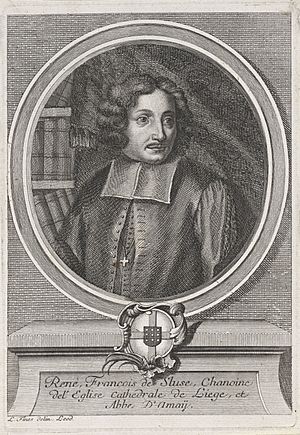René-François de Sluse facts for kids
Quick facts for kids
René-François de Sluse
|
|
|---|---|
 |
|
| Born | 2 July 1622 |
| Died | 19 March 1685 Liège, Spanish Netherlands
|
| Occupation | mathematician and churchman |
René-François Walter de Sluse (born July 2, 1622 – died March 19, 1685) was a very smart Walloon mathematician and church leader. He was known for his important work in mathematics, especially for helping to develop early ideas of calculus. He also served as a canon (a type of priest) in Liège and an abbot (head of a monastery) in Amay.
Contents
Biography
Early Life and Education
René-François Walter de Sluse was born in Visé, which was then part of the Spanish Netherlands. Today, Visé is in Belgium. He began his studies at the University of Leuven from 1638 to 1642.
After Leuven, he went to the University of Rome, La Sapienza. There, he earned a master's degree in law in 1643. While in Rome, he also studied many languages, mathematics, and astronomy. Besides math, he also wrote about physics, natural history, and theology.
Church Career and Connections
In 1650, René-François became a canon in the Catholic Church. Soon after, he became a canon in Liège. In 1666, he took a new job as the abbot of Amay.
His work in the church meant he couldn't travel much to meet other mathematicians. However, he wrote many letters to important thinkers of his time. These included famous mathematicians like Blaise Pascal, Christiaan Huygens, John Wallis, and Michelangelo Ricci. He was also appointed Chancellor of Liège. He became a Fellow of the Royal Society in 1674, which is a big honor for scientists.
He passed away in Liège, Spanish Netherlands.
Math Discoveries
Tangents and Curves
Sluse made important contributions to the early development of calculus. His work focused on spirals, tangents (lines that touch a curve at only one point), and points where curves change direction.
He and another mathematician, Johannes Hudde, found new ways to figure out tangents. These methods were later used by Isaac Newton, one of the most famous scientists ever. Their methods were much simpler than the older ones used by Pierre de Fermat and René Descartes.
Sluse also wrote many papers about spirals and points of inflection (where a curve changes its bending direction). A special curve called the Conchoid of de Sluze is named after him. The mathematician John Wallis described Sluse as "a very accurate and ingenious person." Some of his works were even published in the Transactions of the Royal Society.
See also
- List of Roman Catholic scientist-clerics

